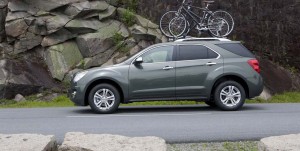The numbers are daunting: 54 separate recalls in just six months impacting nearly 26 million vehicles sold in the U.S., nearly 29 million worldwide. For General Motors that works out to one separate recall nearly every three days. It has a record for any individual manufacturer, and has pushed the overall U.S. auto industry to an all-time record, manufacturers collectively recalling about 39 million vehicles in just six months, 20% more than the previous peak set for all of 2004.
When GM’s recall frenzy began, back in mid-February, with the first recall related to faulty ignition switches, senior executives like CEO Mary Barra were quick to point out that the problems were largely focused on products built by the “Old GM,” before the maker’s 2009 bankruptcy, such as the now abandoned Chevrolet Cobalt. If anything, newer models, such as the 2014 Chevy Impala, they stressed, were winning rave reviews and endorsements from the likes of the Insurance Institute for Highway Safety.
But while GM’s recall frenzy continues to sweep up older products – including this week’s callback of 6.8 million vehicles dating back to 1997 for “unintended ignition key rotation” – a growing number of new models are also being targeted. In fact, a search of GM and federal recall records by TheDetroitBureau.com shows that only three of more than three dozen General Motors products, along with a few model variants, have so far not been subject to recall in 2014.
The only key models not among the list of 54 recalls are:
- The Chevrolet Equinox crossover;
- The GMC Terrain, which shares the same basic crossover platform; and
- The Chevrolet Volt plug-in hybrid.
A few product variants, such as the battery-electric version of the Chevy Spark minicar also have been exempt – so far. But at the current pace, it’s anyone’s guess if those models will remain off the list for long.
Asked about the breadth of the recalls, GM spokesman Alan Adler said in an e-mail, “GM is aggressively reviewing product issues and will not hesitate to conduct a recall if it is determined to be the right thing for customers. We have changed our safety review processes and added 35 investigators so we can move more quickly to address issues as they arise”
(Automakers take just six months to blow through previous full-year recall record. Click Here for more.)
A preliminary search indicates that no other major manufacturer has come close to the product-line breadth that GM has experienced with its recalls in 2014. Toyota likely came closest in 2010 when it recalled a wide array of products for a series of issues ranging from faulty airbags to excess corrosion to unintended acceleration caused by sticky throttles.
What has most surprised industry observers is the apparent lack of impact that GM’s recall problems have so far had on the maker. Industry observers had expected GM to report a sales decline of at least 1% for June, but it actually was up 1% over year-earlier numbers.
(Click Herefor the unexpectedly strong June sales numbers.)
Why is a question many analysts have been debating, but the generally favorable reviews for products like the Chevy Impala and the bow tie brand’s Corvette and Silverado pickup – voted North American Car and Truck of the Year for 2014 – appear to be comforting shoppers who might otherwise steer clear of GM’s four U.S. brands.
If anything, analyst Dave Sullivan of AutoPacific, Inc., says he sees a positive side to the maker’s switch from stonewalling on recalls to ordering callbacks even before it faces pressure from federal safety regulators.
“I like the fact that they’re saying they’re not going to wait,” said Sullivan. “If anything, they’re recalling things even before there’s a statistical trend. They’re starting fresh.”
Whether GM can continue the recall pace during the second half of the year remains to be seen. But CEO Barra was proven wrong when she suggested, more than a month ago, that the worst was over. June alone brought the recall of roughly 12 million vehicles in the U.S.
And eventually, warned Anthony Johndrow, a managing partner with New York’s Reputation Institute, that is bound to have an impact, the “death-of-a-thousand-cuts” syndrome.
(GM ends June with six more recalls covering 7.6 mil US vehicles. Click Here for the story.)
One of the other concerns is whether GM owners might be experiencing so-called “recall fatigue.” The National Highway Traffic Safety Administration has found that only 70% of vehicle owners, on average, bring their cars, trucks or crossovers in for the required fixes. If the same holds true, that means nearly 8 million of the GM vehicles covered by U.S. recalls this year could potentially go unrepaired
“That’s a significant number of vehicles on the road, and whether or not you own one you’ll be driving next to one,” said analyst Sullivan, adding, “That’s an alarming thought.”



There is something to be said for the mechanical basics that cars once incorporated. Growing up as a car-addict kid in the late 50’s & 60’s , I remember that all GM cars had an ignition where you could pull the key out and still start the car, built with “dog ears” to operate it as a switch. My dad, uncles and adults I knew left the cars with the ignition “open” because it was too much hassle to fumble for keys. The fear of car theft was minimal, and the convenience was more important. Not saying we should necessarily regress to that, but these ignitions were made of metal, were extremely durable and could be replaced by the owner of the car. I kind of think the “Key” to the GM ignition nightmare may contain the words, “Low Bidder”.
I have a question if you don’t mind. How did they leave the ignition “open” w/o damage to the charging system? Leaving the ignition in the “on” position left the ignition circuit on, which can and will lead to damage. I mean, yes, electronic ignitions and such were not on vehicles yet, but they still had generators, distributor coil, voltage regulator and such.
Also, I’ve restored / rebuilt 50s/60s GMs and they didn’t have those dog ears as the igntion switch was on the dash. I believe the dog ears didn’t come out until the late 60s when they put the ignition switch on the column. But in any event you could easily turn the in-dash cylinder w/o a key, you just needed to just get past the lock, or just reach under and cross a couple wires.
Unfortunately almost all contracts for purchased components for autos and many other products are given to the low bidder. That is precisely why the low bidder should be held accountable if they deliver defective goods such as the recent airbag disaster with Takata.
It’s unknown if the GM ignition switch was an internal design defect, a production defect or simply a wear issue. Because GM handled the situation poorly, now they will be crucified.
I know for a fact that GM and other U.S. car makers are using a lot of products produced in Korea and they have had large runs of defective goods that made it into vehicles…
Go to any industrial park in the U.S. and check the names on the buildings and see if you can pronounce them. Sad, very sad!